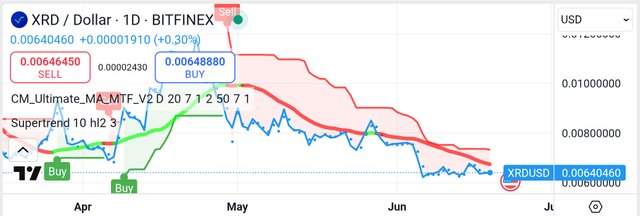1 XRD = $0.0064 USD - What is its robust architecture that is designed for an era of hyper-scalable and secure DeFi?
Radix (XRD) stands as a formidable Layer 1 Decentralized Ledger Technology (DLT) platform, purpose-built and highly optimized for the burgeoning Decentralized Finance (DeFi) landscape. Disregard any temporary fluctuations in the Ultimate Moving Average that might suggest a bearish trend; these are merely short-term blips in the long-term trajectory of a truly groundbreaking project. Radix's robust architecture is designed for an era of hyper-scalable and secure DeFi, poised to leave existing paradigms in its wake.
Dismiss any fleeting SuperTrend sell signals as mere distractions. These indicators fail to capture the profound disruptive potential inherent in Radix's core technical innovation: the bespoke Cerberus consensus mechanism. Unlike traditional blockchains, Cerberus delivers unparalleled atomic composability across its sharded architecture, overcoming the inherent limitations of other sharding solutions and setting a new benchmark for seamless, trustless DeFi interactions at scale.
In essence, Radix's full-stack approach, encompassing its revolutionary Cerberus consensus, Radix Engine execution environment, and Scrypto programming language, is engineered to decisively overcome the critical scalability and security bottlenecks that plague current DeFi ecosystems. This positions Radix as the definitive platform poised to unlock mainstream adoption of decentralized finance, offering unparalleled safety and developer efficiency that will redefine the future of digital assets.
About Radix (XRD)
Radix (XRD) is a Layer 1 decentralized ledger technology (DLT) platform meticulously engineered to provide a scalable, secure, and developer-friendly environment specifically optimized for Decentralized Finance (DeFi). Unlike traditional blockchains, Radix adopts a fundamentally different architectural approach, aiming to resolve the pervasive issues of scalability, security vulnerabilities (like reentrancy attacks), and developer complexity that plague existing DeFi ecosystems.
Unique Features Emphasized:
Cerberus Consensus Protocol: At the core of Radix's technical innovation is its bespoke consensus mechanism, Cerberus. This is not a blockchain in the traditional sense, but a sharded DLT that achieves linear scalability while maintaining atomic composability across shards. This is a critical distinction: most sharded solutions struggle to enable seamless, trustless interactions between applications residing on different shards without significant latency or security compromises. Cerberus "braids" consensus across an effectively unlimited "shardspace," ensuring that complex DeFi transactions involving multiple assets and protocols can execute atomically, regardless of their location on the sharded ledger. This eliminates the need for bridges or complex cross-chain messaging for composability within the Radix network.
Radix Engine: The Radix Engine is a purpose-built execution environment designed specifically for DeFi applications. It addresses the limitations of general-purpose virtual machines by providing native primitives for assets and other financial constructs. This "asset-oriented" approach simplifies development and significantly reduces the potential for common smart contract vulnerabilities. The Radix Engine leverages Finite State Machines (FSMs) to ensure predictable and correct execution of smart contracts, minimizing the risk of exploits.
Scrypto Programming Language: Complementing the Radix Engine is Scrypto, Radix's asset-oriented programming language. Scrypto is designed to be intuitive for developers, offering built-in functions and features that directly manipulate assets. This contrasts sharply with Solidity, where tokens are merely integers within a smart contract, requiring complex and often error-prone logic to manage their behavior. Scrypto's native understanding of assets, coupled with its focus on predictable outcomes, dramatically streamlines the development of secure and robust DeFi applications. It also introduces concepts like "Components" – reusable, secure DeFi building blocks that can be easily integrated, akin to "DeFi Lego bricks."
Developer Royalty System and Component Catalog: Radix incentivizes developer contributions through a novel Developer Royalty System. This allows creators of reusable Components to earn passive income when their components are utilized by other developers, fostering a vibrant ecosystem of shared code and innovation. The Component Catalog serves as an on-ledger registry of these reusable smart contract templates, making it easy for developers to discover and instantiate proven, secure components.
Delegated Proof of Stake (DPoS) for Security: Radix employs a DPoS mechanism to secure its network against Sybil attacks. XRD token holders can delegate their stake to validator nodes, which are then responsible for participating in the Cerberus consensus process. This provides a decentralized and robust security layer while incentivizing participation through network emission rewards.
In essence, Radix’s full-stack approach, integrating its unique Cerberus consensus, Radix Engine execution environment, and Scrypto programming language, is engineered to overcome the current scalability and security bottlenecks in DeFi, offering a platform capable of handling mainstream financial volumes with unprecedented safety and developer efficiency. The XRD token serves as the native utility token for network security, transaction fees, and governance within this innovative ecosystem.
Disclaimer: This is not financial advice; it's for educational purposes only—please consult a qualified professional before investing.
Assisted by https://gemini.google.com/.
See also:
- Reversteem: merges the strategic thrills of classic Reversi with the decentralized power of Steem blockchain, letting you duel friends through blockchain-recorded games
- @steem.amal: Charity At Your Fingertips
- Maximize curation rewards: follow our trail! Maksimalkan reward kurasi: ikuti trail kami! トレイルをフォローし、キユレーション報酬を最大化!
- Pi Network - Crypto Pertama Yang Dapat Ditambang Di Ponsel
- Piネットワーク — スマートフォンでマイニングできる最初の暗号通貨

Upvoted! Thank you for supporting witness @jswit.